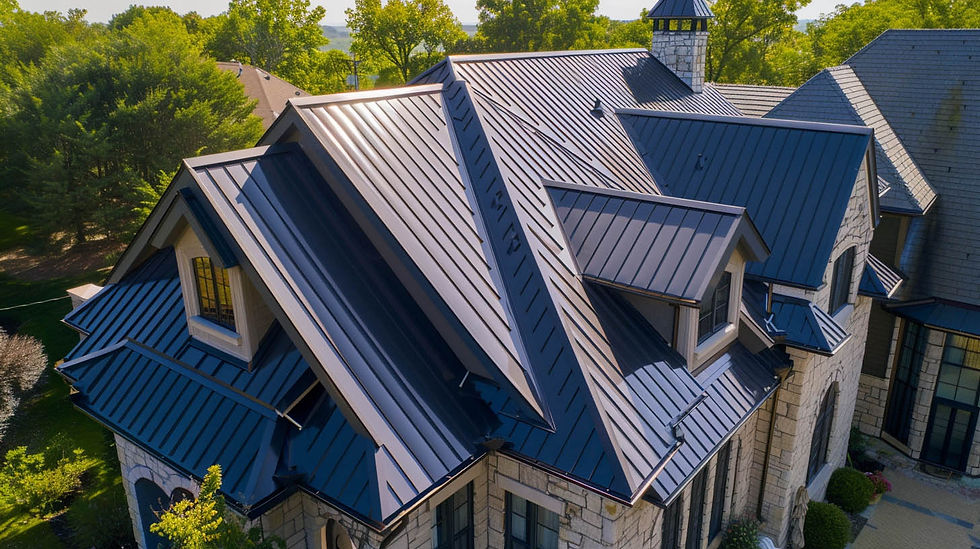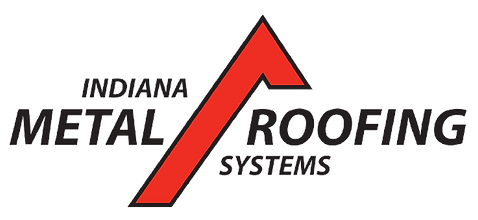Aluminum vs. Steel Roofing: Cost, Durability, and Best Applications
- Joseph Justice
- Oct 10
- 7 min read
When investing in a new metal roof for your Fort Wayne, IN home, you’re choosing a durable solution. Aluminum and steel are two popular options offered by companies like Indiana Metal Roofing Systems. Selecting the right material is crucial, especially considering Fort Wayne's unique harsh weather conditions. This guide helps you compare these two roofing choices based on cost, durability, and their best applications for your home.
Comparing Aluminum and Steel Roofing for Indiana Homes
Both aluminum roofing and steel roofing are fantastic choices that offer superior protection compared to traditional materials. Your decision, particularly an informed decision, depends on your specific needs, budget, and local climate. For your next roofing project, understanding the unique benefits of each material is the first step toward making a confident choice.
As your trusted Fort Wayne roofing contractor, we want to give you all the details about a new roof. Below, we’ll explore different metal roofing materials and explain why a metal roof is such a smart investment for homeowners in our area.
Overview of Metal Roofing Materials
When choosing metal roofing, common options are steel and aluminum, with premium choices like architectural shingles, copper, and zinc. Steel is strong, affordable, and protected by galvanized or galvalume finishes. Aluminum is lighter and naturally rust-resistant. Copper and zinc offer exceptional durability and distinctive looks but are much more expensive. For most homeowners, the choice is between steel and aluminum, based on cost, material thickness, and protective coatings.

Why Metal Roofs Are Popular in Fort Wayne, IN
Metal roofs are popular among Fort Wayne homeowners for their durability, low maintenance, and impressive aesthetic appeal. Standing seam metal roofs withstand harsh weather and require fewer replacements, making them a cost-effective option.
Metal roofing materials like aluminum and steel also improve energy efficiency by offering better insulation and reflecting solar heat. This reduces energy costs and provides various metal roofing options that boost home comfort and benefit the environment, even in extreme weather—making metal roofs a smart choice for eco-conscious residents.
Cost Breakdown: Aluminum vs. Steel Roofing
Understanding the metal roof cost is a crucial step in planning your project, especially if you are considering replacing an old roof. Both aluminum roofing costs and steel roofing prices are influenced by more than just the material itself. Factors like the complexity of your roof and the labor costs for installation play a big part in the final price.
While steel is often seen as the more budget-friendly option, it's important to look at the complete picture. Let's break down the roofing costs, from the price per square foot to what you can expect for installation for different square feet of roofing.
Average Cost Per Square Foot
In 2025, aluminum roofing costs about $15–$20 per square foot, depending on thickness, finish, style, and the size of your roof. Metal shingles and steel roofing are more affordable at $10–$15 per square foot while still offering strength and durability.
Homeowners should weigh aluminum’s durability and low maintenance against steel’s lower cost and strong performance. The best choice depends on budget, long-term value, and desired appearance.

Installation Costs: Aluminum and Steel Compared
Installing a metal roof requires specialized skills, making labor a significant expense—typically $3 to $7 per square foot, depending on roof complexity and material, including options like shingle roofing. However, installation costs for aluminum and steel roofs are usually similar. Both require experienced contractors and specialized techniques, so labor quotes don’t vary much between the two. The main cost difference comes from the materials, not labor.
Factors That Influence Price Differences
Price differences between aluminum and steel roofing stem from several factors. Aluminum is more expensive due to its lightweight, corrosion-resistant properties. Roof complexity, such as intricate designs or larger roof’s sizes, increases labor and material costs. Aluminum installation often needs specialized skills, raising labor expenses, while steel is generally easier to install. Regional market conditions, including local demand and material availability, also affect pricing. Consider these factors when budgeting for your roofing project.
Evaluating Long-Term Value and Savings
The upfront cost is only part of the story compared to an asphalt roof. To truly understand the value of a metal roof, you have to think about what you’ll save in the long run. Lower maintenance expenses, significant energy savings, and far fewer worries about a premature roof replacement make metal a smart financial choice.
When comparing aluminum and steel, both offer incredible long-term benefits over traditional materials like asphalt, enhancing your home's curb appeal. Let’s look at how their maintenance needs and lifespans contribute to their overall value over decades of performance.

Maintenance Expenses Over Time
Metal roofs require minimal maintenance compared to asphalt shingle roofs. Aluminum is naturally rust- and corrosion-resistant, needing virtually no upkeep—even in humid conditions—making it a true “set it and forget it” option.
Steel roofs are highly durable but can rust if their protective coating is damaged. While modern coatings are tough, occasional inspections for deep scratches help ensure longevity and keep maintenance costs low. The type of metal used in roofing can significantly impact durability and maintenance.
Lifespan and Replacement Frequency
Metal roofs are attractive to homeowners for their longevity—aluminum lasts 40-70 years, steel 50-75 years. Their durability reduces replacements and long-term costs compared to traditional asphalt shingles. Both types resist harsh weather, lowering the risk of water damage. While metal roofing may have higher upfront costs, its lifespan and low maintenance offer lasting value. Knowing the material’s lifespan helps balance initial cost with long-term benefits.
Best Applications: Residential and Commercial Use
So where do aluminum roofing and steel roofing work best? The answer depends on your specific roofing project, whether it's for your home or a commercial building. Both types of metal roofing play a crucial role in being versatile enough for nearly any application, but each has scenarios where it truly shines.
For homeowners, the choice often comes down to balancing budget, desired look, and long-term performance of clay tile roofing. We’ll dive into how each material can complement your home’s style and contribute to your energy goals.

Which Roof Suits Your Home’s Style and Needs?
Choosing the right roof for your home depends on a variety of factors, including your home's architectural style, functional requirements, and personal preferences. Aluminum roofing offers sleek aesthetics and lightweight properties, making it an excellent option for modern designs. On the other hand, steel roofing provides exceptional strength and longevity, making it suitable for harsher climates. Additionally, the square footage of your roof is essential to consider in your assessment of design preferences and budget, ensuring you select the best roofing material that will meet your specific needs and enhance your home's value.
Energy Efficiency and Eco-Friendly Features
Energy efficiency is crucial when choosing roofing materials, and additional materials, such as underlayment or flashing, can enhance this aspect further. Metal roofs, especially aluminum and steel, offer superior insulation and reflect solar heat, lowering cooling costs in summer. In contrast, asphalt shingles absorb more heat and increase energy use. Standing seam metal roofs further improve thermal performance.
Eco-friendly benefits are also significant. Aluminum and steel roofs, especially on larger roofs, are highly recyclable and often made with recycled content, reducing environmental impact. They also need less maintenance than traditional options, minimizing waste. Choosing metal roofing lowers energy bills and supports sustainable construction for homes and businesses.
Why Trust Indiana Metal Roofing Systems?
Indiana Metal Roofing Systems stands out for its exceptional craftsmanship and a strong commitment to customer service, along with top-tier ratings that reflect our dedication to excellence. Residents across the region trust us because of our extensive experience and unwavering dedication to quality installations, as we focus on the overall cost-effectiveness of our services. We ensure that your roofing needs are met with the utmost professionalism and reliability, providing peace of mind. When it comes to protecting your home, choose the best for your roofing needs and invest in a durable solution!

Our Craftsmanship, Ratings, and Customer Service
Our awards, including an A+ BBB rating and a 5 Star Google rating, reflect our commitment to customer satisfaction, which is our top priority, as shown by our high ratings and testimonials. We simplify complex roofing projects with clear communication on costs and timelines, delivering a hassle-free experience and a roof that is both beautiful, like copper roofing, and built to last. We focus on #1 quality of craftsmanship, the best quality of materials, and we pride ourselves on no high-pressure sales tactics, offering the industry's best financing options and fair pricing.
What’s Next
In summary, choosing between aluminum and steel roofing depends on your budget, durability needs, and home requirements, including roof size. Aluminum is lightweight and resistant to corrosion, while steel offers superior strength and long-term value. At Indiana Metal Roofing Systems, we deliver expert craftsmanship and outstanding service to ensure the best roofing solution for you. Contact us today to explore your options!
Frequently Asked Questions
Is aluminum or steel roofing more cost-effective for residential use?
For residential use, steel roofing is often more cost-effective upfront due to its lower material costs. However, aluminum roof installation can provide better long-term value in humid climates by preventing rust-related repairs, making the total cost of a metal roof comparable over its lifespan.
How do maintenance requirements differ between aluminum and steel roofs?
The maintenance requirements are minimal for both, but aluminum roofing has a slight edge as it's naturally rust-proof. Steel roofing is very durable but may require occasional inspections to ensure its protective coating hasn’t been scratched, preventing any potential for rust and avoiding a premature roof replacement, which can be crucial considering the national average cost of roof replacements.
Can switching from steel to aluminum roofing save money over time?
Yes, in certain situations, an aluminum roof can save you money in the long run. Though the initial cost of a metal roof made from aluminum might be higher, its superior rust resistance can prevent future repair costs that a steel roofing system might incur in a wet or coastal climate, providing the best value overall.


Comments